考虑风电随机性的微网多时间尺度能量优化调度_徐立中
- 格式:pdf
- 大小:537.80 KB
- 文档页数:8
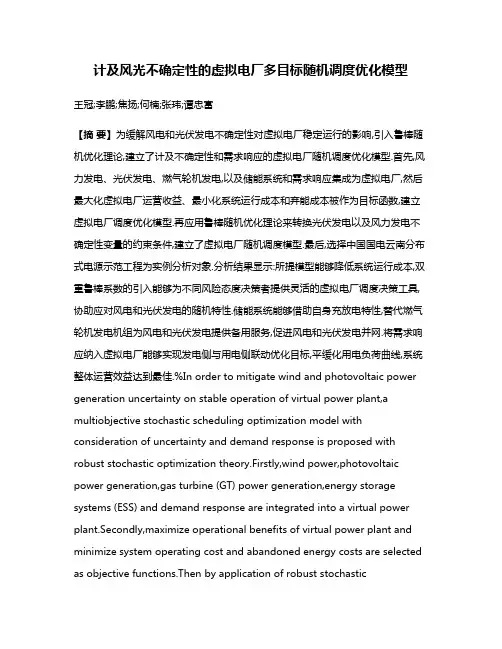
计及风光不确定性的虚拟电厂多目标随机调度优化模型王冠;李鹏;焦扬;何楠;张玮;谭忠富【摘要】为缓解风电和光伏发电不确定性对虚拟电厂稳定运行的影响,引入鲁棒随机优化理论,建立了计及不确定性和需求响应的虚拟电厂随机调度优化模型.首先,风力发电、光伏发电、燃气轮机发电,以及储能系统和需求响应集成为虚拟电厂,然后最大化虚拟电厂运营收益、最小化系统运行成本和弃能成本被作为目标函数,建立虚拟电厂调度优化模型.再应用鲁棒随机优化理论来转换光伏发电以及风力发电不确定性变量的约束条件,建立了虚拟电厂随机调度模型.最后,选择中国国电云南分布式电源示范工程为实例分析对象.分析结果显示:所提模型能够降低系统运行成本,双重鲁棒系数的引入能够为不同风险态度决策者提供灵活的虚拟电厂调度决策工具,协助应对风电和光伏发电的随机特性.储能系统能够借助自身充放电特性,替代燃气轮机发电机组为风电和光伏发电提供备用服务,促进风电和光伏发电并网.将需求响应纳入虚拟电厂能够实现发电侧与用电侧联动优化目标,平缓化用电负荷曲线,系统整体运营效益达到最佳.%In order to mitigate wind and photovoltaic power generation uncertainty on stable operation of virtual power plant,a multiobjective stochastic scheduling optimization model with consideration of uncertainty and demand response is proposed with robust stochastic optimization theory.Firstly,wind power,photovoltaic power generation,gas turbine (GT) power generation,energy storage systems (ESS) and demand response are integrated into a virtual power plant.Secondly,maximize operational benefits of virtual power plant and minimize system operating cost and abandoned energy costs are selected as objective functions.Then by application of robust stochasticoptimization theory,a virtual power plant (VPP) scheduling optimization model is established.The proposed method is applied to distributed power demonstration project in Yunnan,China as an example.The results show that the proposed model can reduce system power shortage penalty cost.The introduction of dual Robust coefficients can provide flexible VPP scheduling decision tools for different risk attitudes of decision makers and respond to wind power and photovoltaic power generation stochastic characteristics effectively.ESS can replace GT unit to provide backup services for wind power and photovoltaic power generation because of its charge and discharge characteristics.It can also smooth VPP output power curve and promote grid connection between wind power and photovoltaic power generation.Demand response is incorporate into VPP to realize power generation side and power side linkage optimization,smooth electric load curve and improve overall operational effectiveness.【期刊名称】《中国电力》【年(卷),期】2017(050)005【总页数】7页(P107-113)【关键词】鲁棒随机优化理论;虚拟电厂;随机调度优化模型;风电;光伏发电【作者】王冠;李鹏;焦扬;何楠;张玮;谭忠富【作者单位】华北电力大学能源经济与环境研究所,北京 102206;国网河南省电力公司经济技术研究院,河南郑州450052;华北电力大学能源经济与环境研究所,北京102206;国网节能服务有限公司北京 100191;华北电力大学能源经济与环境研究所,北京 102206;华北电力大学能源经济与环境研究所,北京 102206【正文语种】中文【中图分类】TM732能源危机和环境污染日渐严峻,以风能、太阳能为代表的分布式可再生能源在能源格局中的角色日益重要。
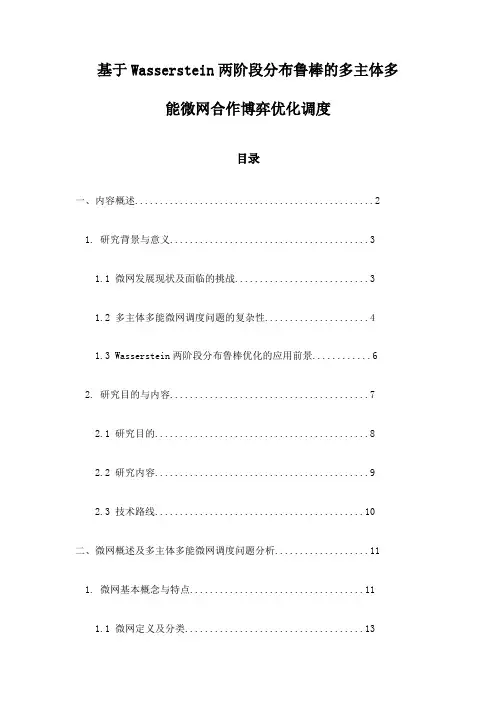
基于Wasserstein两阶段分布鲁棒的多主体多能微网合作博弈优化调度目录一、内容概述 (2)1. 研究背景与意义 (3)1.1 微网发展现状及面临的挑战 (3)1.2 多主体多能微网调度问题的复杂性 (4)1.3 Wasserstein两阶段分布鲁棒优化的应用前景 (6)2. 研究目的与内容 (7)2.1 研究目的 (8)2.2 研究内容 (9)2.3 技术路线 (10)二、微网概述及多主体多能微网调度问题分析 (11)1. 微网基本概念与特点 (11)1.1 微网定义及分类 (13)1.2 微网的优势与挑战 (14)2. 多主体多能微网调度问题解析 (14)2.1 多主体概述 (16)2.2 多能微网的能源类型及特点 (17)2.3 调度问题的难点与挑战 (18)三、Wasserstein两阶段分布鲁棒优化理论 (19)1. Wasserstein距离概念及性质 (21)1.1 Wasserstein距离定义 (21)1.2 Wasserstein距离的性质与应用领域 (23)2. 两阶段分布鲁棒优化理论介绍 (24)2.1 分布鲁棒优化的基本概念 (25)2.2 两阶段分布鲁棒优化的原理及步骤 (26)四、基于Wasserstein两阶段分布鲁棒的多主体多能微网合作博弈优化调度模型构建281. 模型假设与符号说明 (29)1.1 模型假设 (30)1.2 符号说明与定义 (31)2. 优化调度模型建立 (32)一、内容概述本文档主要研究了基于Wasserstein两阶段分布鲁棒的多主体多能微网合作博弈优化调度问题。
在这个问题中,我们考虑了一个由多个智能体组成的微网,这些智能体具有不同的能量存储能力和计算能力。
为了实现微网的能量高效利用和优化调度,我们需要设计一个合适的合作博弈策略,使得各个智能体能够在满足自身需求的同时,为整个微网提供稳定的能量供应。
为了解决这个问题,我们首先引入了Wasserstein距离的概念,将微网中各个智能体的能量分布看作是空间中的点,通过Wasserstein距离可以衡量这些点之间的相似性。
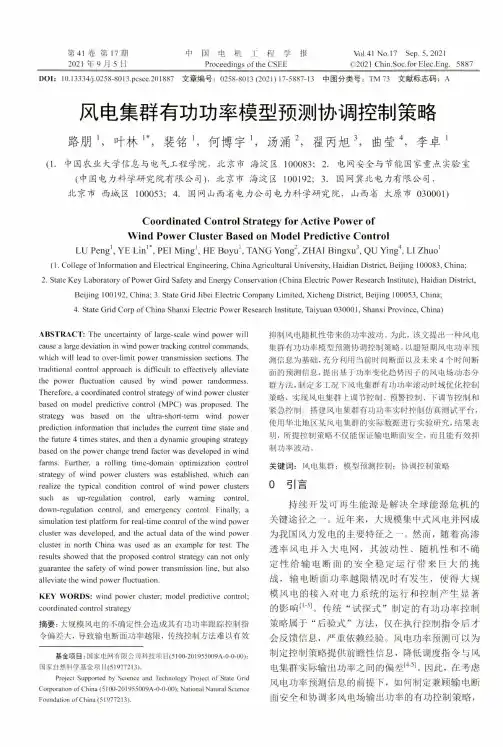
第41卷第17期中国电机工程学报Vol.41 No.17 Sep. 5,20212021 年 9 月5 日Proceedings of the CSEE ©2021 Chin.Soc.for Elec.Eng. 5887 DOI:10.13334/j.0258-8013.pcsee.201887 文章编号:0258-8013 (2021) 17-5887-13 中图分类号:TM 73 文献标志码:A风电集群有功功率模型预测协调控制策略路朋S叶林|+,裴铭、何博宇、汤涌2,翟丙旭3,曲萤4,李卓1(1.中国农业大学信息与电气工程学院,北京市海淀区100083; 2.电网安全与节能国家重点实验室(中国电力科学研究院有限公司),北京市海淀区100192; 3.国网冀北电力有限公司,北京市西城区100053; 4.国网山西省电力公司电力科学研究院,山西省太原市030001)Coordinated Control Strategy for Active Power ofWind Power Cluster Based on Model Predictive ControlL U Peng1,Y E Lin1 ,PEI M i n g1,H E B o y u1,T A N G Yon g2,Z H A I Bingxu3,Q U Ying4,LI Z h u o1(1. College of Information and Electrical Engineering, China Agricultural University, Haidian District, Beijing 100083, China;2. State Key Laboratory of Power Gird Safety and Energy Conservation (China Electric Power Research Institute), Haidian District,Beijing 100192, China; 3. State Grid Jibei Electric Company Limited, Xicheng District, Beijing 100053, China;4. State Grid Corp of China Shanxi Electric Power Research Institute, Taiyuan 030001, Shanxi Province, China)ABSTRACT: The uncertainty of large-scale wind power will cause a large deviation in wind power tracking control commands, which will lead to over-limit power transmission sections. The traditional control approach is difficult to effectively alleviate the power fluctuation caused by wind power randomness. Therefore, a coordinated control strategy of wind power cluster based on model predictive control (MPC) was proposed. The strategy was based on the ultra-short-term wind power prediction information that includes the current time state and the future 4 times states, and then a dynamic grouping strategy based on the power change trend factor was developed in wind farms. Further, a rolling time-domain optimization control strategy of wind power clusters was established, which can realize the typical condition control of wind power clusters such as up-regulation control, early warning control, down-regulation control, and emergency control. Finally, a simulation test platform for real-time control of the wind power cluster was developed, and the actual data of the wind power cluster in north China was used as an example for test. The results showed that the proposed control strategy can not only guarantee the safety of wind power transmission line, but also alleviate the wind power fluctuation.KEY WORDS: wind power cluster; model predictive control; coordinated control strategy摘要:大规模风电的不确定性会造成其有功功率跟踪控制指 令偏差大,导致输电断面功率越限,传统控制方法难以有效基金项目:国家电网有限公司科技项目(5100-20丨955009A-0-0-00); 国家自然科学基金项目(51977213)。
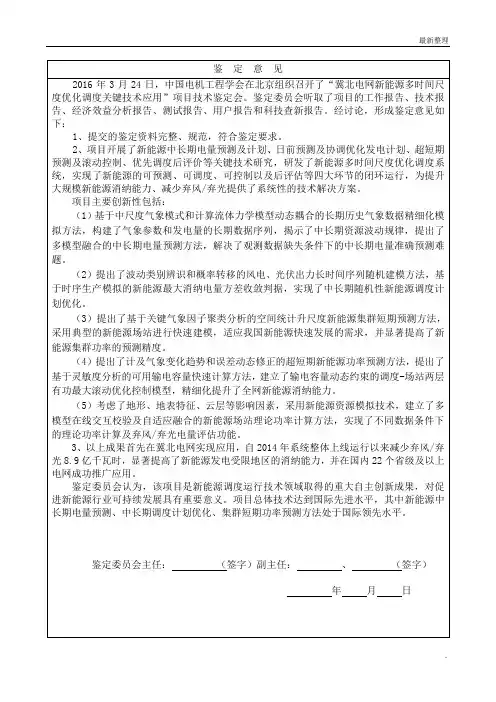
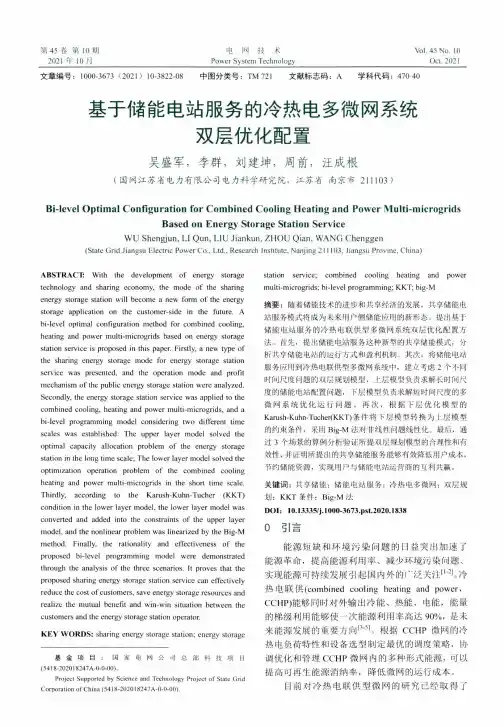
第45卷第丨0期2021年10月电网技术Power System TechnologyVol.45 No. 10Oct. 2021文章编号:1000-3673 (2021) 10-3822-08 中图分类号:TM 721 文献标志码: A 学科代码:470 40基于储能电站服务的冷热电多微网系统双层优化配置吴盛军,李群,刘建坤,周前,汪成根(国网江苏省电力有限公司电力科学研究院,江苏省南京市211103)Bi-level Optimal Configuration for Combined Cooling Heating and Power Multi-microgridsBased on Energy Storage Station ServiceWU Shengjun,LI Qun,LIU Jiankun,ZHOU Qian,WANG Chenggen(State Grid Jiangsu Electric Power Co., Ltd., Research Institute, Nanjing 211103, Jiangsu Provine, China)ABSTRACT: With the development of energy storage technology and sharing economy, the mode of the sharing energy storage station will become a new form of the energy storage application on the customer-side in the future. A bi-level optimal configuration method for combined cooling, heating and power multi-microgrids based on energy storage station service is proposed in this paper. Firstly, a new type of the sharing energy storage mode for energy storage station service was presented, and the operation mode and profit mechanism of the public energy storage station were analyzed. Secondly, the energy storage station service was applied to the combined cooling, heating and power multi-microgrids, and a bi-level programming model considering two different time scales was established: The upper layer model solved the optimal capacity allocation problem of the energy storage station in the long time scale; The lower layer model solved the optimization operation problem of the combined cooling heating and power multi-microgrids in the short time scale. Thirdly, according to the Karush-Kuhn-Tucher (KKT) condition in the lower layer model, the lower layer model was converted and added into the constraints of the upper layer model, and the nonlinear problem was linearized by the Big-M method. Finally, the rationality and effectiveness of the proposed bi-level programming model were demonstrated through the analysis of the three scenarios. It proves that the proposed sharing energy storage station service can effectively reduce the cost of customers, save energy storage resources and realize the mutual benefit and win-win situation between the customers and the energy storage station operator.KEY WORDS: sharing energy storage station; energy storage基金项目:国家电网公司总部科技项目(5418-202018247A-0-0-00)。

电力系统中的风光储一体化调度优化研究随着气候变化日益严峻的形势和全球对可再生能源的需求日益增长,风力和光伏发电已经成为了现代电力系统中不可或缺的组成部分。
然而,由于风力和光伏发电的间歇性和不稳定性,其在电力系统中的集成面临一系列的技术挑战。
为了解决这些问题,风光储一体化技术应运而生。
本文将探讨电力系统中的风光储一体化调度优化的研究。
风光储一体化技术的基本原理是将风力发电和光伏发电与储能技术有机地结合起来,以便在供电不足或电网负荷过高时能够实现能量存储和释放。
通过储能系统,风力和光伏发电可以将其产生的电力存储起来,以便在需要时能够供应给电力系统。
这种一体化调度的关键在于找到最优的调度策略,以最大化可再生能源利用,保证电力系统的可靠性和经济性。
在优化调度方面,主要存在三个问题:最优发电调度问题、储能装置容量配置问题和电网容量优化问题。
首先,最优发电调度问题是指如何合理安排风力和光伏发电的输出功率,以使得系统总体效益最大化。
这个问题涉及到对风力和光伏发电的输出进行预测和调度的方法,以及对电力系统的负荷需求进行准确预测的技术。
其次,储能装置容量配置问题是指如何确定合适的储能装置容量,以应对不同的电力系统需求。
储能设备的容量大小直接影响到风光储一体化系统的性能和经济效益。
因此,在进行储能装置的容量配置时,需要考虑到系统稳定性、经济性和环境可持续发展的要求。
最后,电网容量优化问题是指如何通过合理规划电力系统的输电线路和变电站容量,以满足风光储一体化设备的供应需求。
由于风光储一体化系统通常分布在电力系统的各个节点,因此需要对电网进行优化设计,以确保风光储一体化系统的稳定运行,并降低电网的损耗和成本。
为了解决以上问题,研究学者们提出了不同的优化调度方法和算法。
一种常用的方法是基于模型预测控制(Model Predictive Control,MPC)的调度优化方法。
该方法通过建立数学模型来预测风力和光伏发电的输出及负荷需求,以根据最优控制策略来调整发电和储能的功率输出。
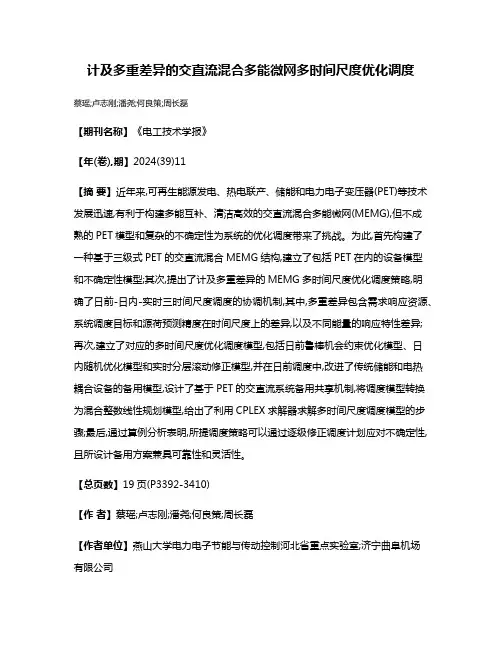
计及多重差异的交直流混合多能微网多时间尺度优化调度蔡瑶;卢志刚;潘尧;何良策;周长磊【期刊名称】《电工技术学报》【年(卷),期】2024(39)11【摘要】近年来,可再生能源发电、热电联产、储能和电力电子变压器(PET)等技术发展迅速,有利于构建多能互补、清洁高效的交直流混合多能微网(MEMG),但不成熟的PET模型和复杂的不确定性为系统的优化调度带来了挑战。
为此,首先构建了一种基于三级式PET的交直流混合MEMG结构,建立了包括PET在内的设备模型和不确定性模型;其次,提出了计及多重差异的MEMG多时间尺度优化调度策略,明确了日前-日内-实时三时间尺度调度的协调机制,其中,多重差异包含需求响应资源、系统调度目标和源荷预测精度在时间尺度上的差异,以及不同能量的响应特性差异;再次,建立了对应的多时间尺度优化调度模型,包括日前鲁棒机会约束优化模型、日内随机优化模型和实时分层滚动修正模型,并在日前调度中,改进了传统储能和电热耦合设备的备用模型,设计了基于PET的交直流系统备用共享机制,将调度模型转换为混合整数线性规划模型,给出了利用CPLEX求解器求解多时间尺度调度模型的步骤;最后,通过算例分析表明,所提调度策略可以通过逐级修正调度计划应对不确定性,且所设计备用方案兼具可靠性和灵活性。
【总页数】19页(P3392-3410)【作者】蔡瑶;卢志刚;潘尧;何良策;周长磊【作者单位】燕山大学电力电子节能与传动控制河北省重点实验室;济宁曲阜机场有限公司【正文语种】中文【中图分类】TM732【相关文献】1.计及不同主体的含PET交直流混合微网双层优化调度2.计及源荷不确定性的独立型交直流混合微网多能源协调优化调度3.计及多能共享的互联微能源网的分布式协同优化调度4.考虑多重不确定性的交直流混合微网多目标优化运行因版权原因,仅展示原文概要,查看原文内容请购买。